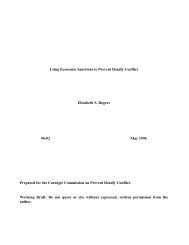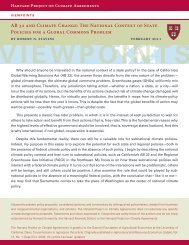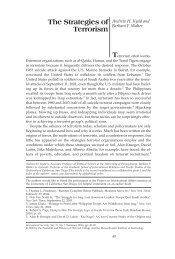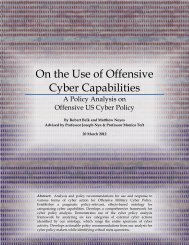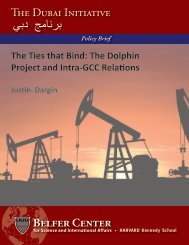Plutonium Mountain - Belfer Center for Science and International ...
Plutonium Mountain - Belfer Center for Science and International ...
Plutonium Mountain - Belfer Center for Science and International ...
- No tags were found...
You also want an ePaper? Increase the reach of your titles
YUMPU automatically turns print PDFs into web optimized ePapers that Google loves.
safeguarding plutonium-bearing geologic repositories once non-nuclear-weapon states begin<br />
to establish them. 95 Indeed, Semipalatinsk could be used as a test-bed to demonstrate the techniques<br />
that will be needed in any case to monitor deep underground repositories filled with plutonium-bearing<br />
spent fuel, which are scheduled to begin opening in non-nuclear-weapon states in<br />
the next couple of decades.<br />
5. Longer-Term Worries<br />
<strong>Plutonium</strong> remains dangerous <strong>for</strong> millennia; human institutions rarely remain durable <strong>for</strong> more<br />
than a few hundred years. With substantial amounts of plutonium only covered with concrete<br />
caps, <strong>and</strong> other collections in relatively shallow burial, might some future Kazakh government<br />
try to recover the plutonium in Degelen <strong>Mountain</strong> <strong>and</strong> elsewhere <strong>for</strong> use in a bomb A hundred<br />
or a thous<strong>and</strong> years from now, might this area no longer be watched, <strong>and</strong> scavengers with sophisticated<br />
equipment return to retrieve the plutonium What precedent will be set by establishing<br />
what is in effect a plutonium repository with no international safeguards in a non-nuclear-weapon<br />
state Will either the concrete caps or the cement mixed with the plutonium prevent the plutonium<br />
from leaking out <strong>and</strong> causing environmental dangers hundreds or thous<strong>and</strong>s of years from<br />
now (The containment method used at Smipalatinsk was never analysed in detail as to whether<br />
it meets international safety st<strong>and</strong>ards <strong>for</strong> long-term storage of nuclear waste.) The unofficial<br />
approach, excluding the IAEA <strong>and</strong> other experts, did not encourage deep analysis of these questions,<br />
or independent questioning.<br />
The mismatch between the lifetimes of plutonium <strong>and</strong> of human institutions is a problem that<br />
extends far beyond the steppes of Kazakhstan. The Cold War superpowers, <strong>and</strong> now more recent<br />
nuclear states, have accumulated over a thous<strong>and</strong> tons of weapons-usable nuclear material<br />
– enough <strong>for</strong> tens of thous<strong>and</strong>s of nuclear bombs. Finding a sustainable means of rendering this<br />
material <strong>for</strong>ever safe even without constant human intervention remains one of the central challenges<br />
of the nuclear age.<br />
95<br />
Current thinking suggests that minimal unattended seismic monitoring will be required <strong>for</strong> geologic repositories <strong>for</strong> at least as<br />
long as human civilization continues pursuing nuclear activities on the surface. See, <strong>for</strong> example, Edwin S. Lyman <strong>and</strong> Harold A.<br />
Feiveson, “The Proliferation Risks of <strong>Plutonium</strong> Mines,” <strong>Science</strong> <strong>and</strong> Global Security, Vol. 7, No. 1 (1998), pp. 119-128.<br />
40<br />
<strong>Plutonium</strong> <strong>Mountain</strong>: Inside the 17-year mission to secure a dangerous legacy of Soviet nuclear testing



